Home to some of the world’s most spectacular scenery, the only royal palace in the U.S. and the welcoming aloha spirit, Hawaii is like no place on earth. The glimmering ocean, lava-spewing volcanoes, emerald valleys, towering coastal cliffs, sandy beaches, and sublime luxury hotels & resorts lure thousands of tourists each year, who get lost in the spiritual beauty of the hula and find out how the warmth of Hawaii’s people wonderfully complement the islands’ perfect temperatures. Although Hawaii is comprised of a chain of 132 islands, we usually refer to only a few islands when we think of Hawaii: Maui, Oahu, Kauai, Lanai, Molokai and the Island of Hawaii (more commonly known as the Big Island)
Get the most out of your (luxury) trip to Hawaii with my travel guide. Find out more about:
- Best time to visit
- How to get there
- Travel requirements
- Getting around
- Inspiration, highlights, & travel tips
- Suggested itineraries
- Recommended luxury hotels (+ reviews)
BEST TIME TO VISIT
Hawaii’s off-season – when the best rates are available and the islands are less crowded – is spring (April to June) and autumn (September to November) – a paradox because these are the best seasons to be in Hawaii in terms of reliably great weather. Winter (December to March) can be a surprisingly cloudy and wet affair in the archipelago.
- Spring (April to June) coincides with the end of the high season and the start of the dry season. This is a good period to travel to Hawaii, as the weather is great, sunny and dry, and airfare and lodging prices drop compared to the busy winter months.
- Summer (July and August) offers the hottest weather on the islands, although it never gets too hot because the trade winds cause a constant cooling breeze. It’s also very busy season in Hawaii because of the school holidays, which means more expensive flights and hotel rates. While an extremely rare event, the summer is also the start of the hurricane season in Hawaii, which runs from July through December. Such was the case when category 3 hurricane Iniki came ashore on Kauai in September 1992, the most powerful hurricane to strike Hawaii in recorded history.
- Autumn (September to November) is similar to spring and offers mostly sunny and dry days. The summer tourists have left and the winter tourists still have to arrive, so this is also the cheapest period to travel to and around the islands. On a side note, autumn is not only hurrican season (cf above) but also the time when the trade winds change direction, bringing sometimes stormy, hot, sticky weather onshore. Islanders call this kona weather, because kona means leeward or south, and this points to the direction from which these weather systems arrive.
- Winter (December to March) brings the rains and clouds but the spurts of rain are mostly short-lived and falling overnight. It would be unusual to experience several days of solid rain, although it has happened. This is also Hawaii’s high season, thus, on average, the prices are higher and occupancy rates are higher.
It is also important to keep in mind that there are several fluctuations in the weather pattern dependent on the area where you stay in Hawaii:
- Each island has a leeward side (the side sheltered from the wind) and a windward side (the side that gets the wind’s full force). The leeward sides (the west and south) are usually hot and dry, while the windward sides (east and north) are generally cooler and moist. For example, Hana is located on Maui’s windward side, and experiences an abundance of rain (even in the dry season), what makes the area so verdant; Wailea is located only a few hours away on Maui’s windward side and enjoys a mostly sunny weather even when its raining cats and dogs in Hana. Other rainy windward spots in the Hawaiian islands are Kauai’s famous North Shore and the area around Hilo on the Big Island.
- Many visitors are drawn to Hawaii’s spectacular scenery found in higher elevations such as Kokee on Kauai, Haleakala on Maui or Kilauea on the Big Island. Temperatures in these higher locations drop 3.5° F (2 degrees celsius) for every 1000 feet (300 m) above sea level that you climb, so dress appropriately with pants and several layers of clothing. At an elevation of 10,023 feet (3055 m), the summit of Haleakala can be as much as 30° F (20° C) cooler than resort areas on the coast.
- Many people are drawn to Hawaii because of the dramatic wave action, although this varies dramatically between island coasts and seasons. Summer waters are typically gentle on all beaches. During the winter on many north shore beaches, Pacific storms drive ocean swells towards the islands, creating the Hawaiian Islands’ legendary big waves.
HOW TO GET THERE
Hawaii receives numerous international and domestic daily flights via its five main airports:
- Honolulu International Airport (HNL), also known as Daniel K. Inouye International Airport, is the principal aviation gateway of Hawaii, and is located near the state capital of Honolulu on the island of Oahu. It’s the only airport in Hawaii to handle flights to/from other destinations than the USA mainland and Canada. Click here for a list of airlines that offer direct flights to Honolulu.
- Kahului Airport (OGG) is Hawaii’s second busiest airport and the main getaway the island of Maui. Click here for a list of airlines that offer direct flights to Maui.
- Lihue Airport (LIH) is located on the southeast coast of the island of Kauai. Click here for a list of airlines that offer direct flights to Kauai.
- Kona International Airport (KOA) is the main airport of Hawaii’s Big Island, located on the west coast near the resort areas of North Kona and South Kohala. Click here for a list of airlines that offer direct flights to Kona.
- Hilo International Airport (ITO) is the secondary airport of Hawaii’s Big Island, located on the island’s east coast. Click here for a list of airlines that offer direct flights to Hilo.
If you want to fly to Hawaii in utmost comfort, only few airlines offer a flat seats to the Aloha State.
Before you buy a plane ticket, consider reading my tips & tricks for buying the cheapest plane ticket.
TRAVEL REQUIREMENTS
Hawaii belongs to the USA. Requirements for entry into the USA differ from country to country, and are subject to change. Prior to departure, always check with your government and your nearest USA embassy or consulate what documents you need for travel to Hawaii.
- You need a machine-readable passport (MRP) with at least six months validity to enter the USA. If your passport was issued/renewed after October 26, 2006, you need an ‘e-passport’ with a digital photo and an integrated chip containing biometric data.
- Under the US Visa Waiver Program (VWP), visas are not required for citizens of 38 countries for stays up to 90 days (no extensions) on condition that they have a return ticket (or onward ticket to any foreign destination) that’s nonrefundable in the USA.
- All VWP travelers must register online at least 72 hours before arrival with the Electronic System for Travel Authorization, which currently costs $14 USD. Once approved, registration is valid for two years (or until your passport expires, whichever comes first).
Make sure you read my 10 tips to plan a worry-free trip.
GETTING AROUND
It’s quite easy to get around in Hawaii, and several modes of transportation are available:
- Domestic flights with Hawaiian Airlines are the only way to move around if you want to do some island hopping. Hawaii’s flagcarrier connects the islands daily via multiple flights and the cost of a domestic ticket is often quite cheap if booked in advance. Tickets can be booked online on the website.
- The only islands connected via regular boat service are Maui and Lanai: from the historic Lahaina Harbor in West Maui, you can hop on a ferry for a day trip to the neighbor island of Lanai.
- To really experience Hawaii, you need to rent a car in advance from one of the airports.
- For most islands you can also get around by shuttle, taxi, ride-sharing app such as Uber or Lyft, or public transportation, although that won’t get you close to Hawaii’s famous natural attractions.
- There are plenty of tour operators that offer guided bus tours to conveniently explore the islands.
INSPIRATION, HIGHLIGHTS & TRAVEL TIPS
There are several good reasons why you should put Hawaii on your bucket list:
- Admiring some of the world’s most stunning natural scenery
- Seeing the world’s most active volcano
- Relaxing on gold, red and black beaches
- Hiking some of the USA’s greatest trails
- Whale watching (in winter time)
- Staying at one of the USA’s best beach resorts
It’s important to keep in mind that the Hawaiian archipelago consists of six major islands – Kauai, Oahu, Molokai, Lanai, Maui, and the island of Hawaii – each with its own distinct personality, adventures, activities and sights.
- Oahu is the “heart of Hawaii”, home to the capital city of Honolulu, and famous for legendary surf towns like Haleiwa.
- True to its island roots, Molokai is filled with rustic charm and epic beauty.
- From its famous beaches to the peak of Haleakala, Maui offers a wealth of unforgettable experiences.
- The Island of Hawaii is often dubbed the Big Island and offers lots to see and do, from active volcanoes to coffee farms and beautiful beaches to rich history.
- The oldest and northernmost island in the Hawaiian chain, Kauai is draped in emerald valleys, sharp mountain spires and jagged cliffs aged by time and the elements.
- Lanai is the smallest inhabited island in Hawaiian island and balances restful luxury with rugged terrain.
The following, in-depth articles may also inspire you and help you plan your holiday to Hawaii:
- Top 10 most fabulous luxury resorts in Hawaii
- Top 10 best things to see & do in Hawaii
- Top 10 best things to see & do on the island of Maui
- Top 10 best things to see & do on the island of Kauai
- Airlines that offer flat seats to Hawaii
- Tips & tricks for getting the best deal at a luxury hotel
- Tips & tricks for buying the cheapest plane ticket
SUGGESTED ITINERARIES
It’s impossible to suggest one itinerary for Hawaii, but I hereby share with you a schedule based on my own holidays in Hawaii, which is great if you want to see archipelago in a time frame of three weeks, hereby making use of domestic flights.
- Day 1-3: Oahu: explore Honolulu and Oahu’s North Shore (recommended hotel: The Royal Hawaiian).
- Day 4-6: Lanai: fly to Lanai & stay in luxury while exploring the area (recommended hotel: Four Seasons Lanai).
- Day 7-8: Maui: take the ferry to Maui and rent a car to make the scenic drive to Hana (recommended hotel: Travaasa Hana).
- Day 9-11: Maui: enjoy some sunny relaxation in Wailea but don’t miss the sunrise/sunset from Haleakala (recommended hotel: Andaz Maui).
- Day 12-16: Big Island: fly to the Big Island and explore the island from your base on the west coast (recommended hotel: Four Seasons Hualalai).
- Day 17-21: Kauai: fly to Hawaii’s most spectacular island and explore the breathtaking scenery (recommended hotel: St Regis Princeville).
If you only have two weeks, I recommend to skip Oahu and Lanai, and focus on Maui, the Big Island, and Kauai. If you can only make it to two island, I suggest to visit Maui and Kauai, which I consider to be the most scenic islands in the archipelago.
For the planning of your own travel itinerary in Hawaii, I highly recommend Hawaii’s official tourism website www.gohawaii.com, which boasts plenty of helpful information. In addition, for more ideas, I suggest the excellent Hawaii itineraries as provided by The Rough Guides and Frommers.
RECOMMENDED LUXURY HOTELS (+ REVIEWS)
Please visit my top 10 list of the best luxury hotels in Hawaii if you are eager to know how I rank Hawaii’s top properties, according to my own experience at each one of them.
Below, you find my reviews of luxury hotels in Hawaii (with pros, cons, and tips to save money).
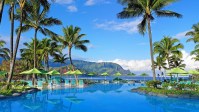 Review: St Regis Princeville Resort, Kauai Island (Hawaii)
Review: St Regis Princeville Resort, Kauai Island (Hawaii) Review: Andaz Maui at Wailea (Hawaii, USA)
Review: Andaz Maui at Wailea (Hawaii, USA)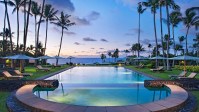 Review: Travaasa Hana, Maui (Hawaii, USA)
Review: Travaasa Hana, Maui (Hawaii, USA)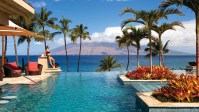 Review: Four Seasons Resort Maui at Wailea (Hawaii, USA)
Review: Four Seasons Resort Maui at Wailea (Hawaii, USA)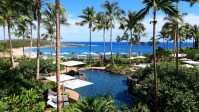 Review: Four Seasons Resort Lanai (Hawaii, USA)
Review: Four Seasons Resort Lanai (Hawaii, USA)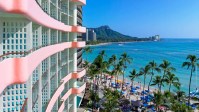 Review: The Royal Hawaiian Resort (Honolulu, Hawaii)
Review: The Royal Hawaiian Resort (Honolulu, Hawaii)
*** Follow me on Twitter, Instagram and Facebook for a daily moment of travel inspiration ***


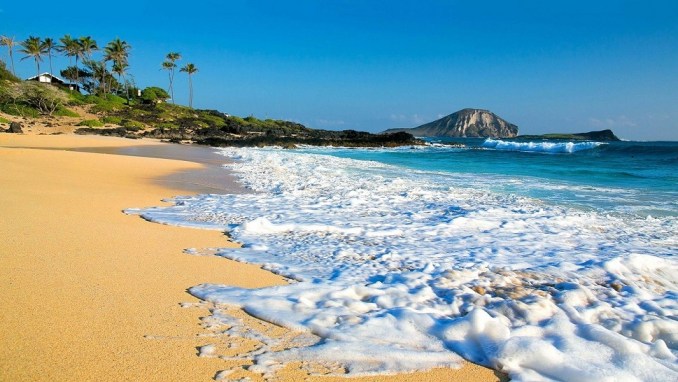
Thanks for this useful blog. I am planning to go Hawaii this December I hope i can eat a affordable foods their together with my girlfriend and family. See you soon Hawaii.